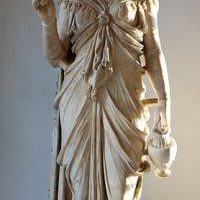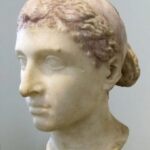Isis was the Egyptian goddess of fertility, protector of families. One of the incarnations of the Great Mother; later identified with the Greek Demeter. Her sacred animal was a cow. Temples dedicated to the goddess were given two different names: either Serapeon (from the name of her partner – Serapis) or Isidejon (from her own name).
From Egypt, the cult of the goddess spread to all Greek colonies and throughout the Mediterranean, mainly in coastal cities, where she was venerated as the patroness of seafarers and merchants, with the nickname Pelagia, meaning “Sea”. In Greece, in Corinth, she became so popular that she took the place of the city’s chief deity. In the 2nd century BCE, her cult reached Sicily and Italy. In Campania, in Puteoli, then the most important port city in the south, the Serapejon was built, and in Herculaneum and Pompeii, the Isidium. From here, the cult of the goddess reached Rome. Emperor Caligula built a temple to Isis in the Field of Mars, known there as Field Isis (Isis Campensis). In northern Italy, the main centre of worship was Aquileia. The greatest development of the cult of Isis took place during the formation of Christianity. Its followers were also the rulers: Commodus and Domitian.
The main festival of Isis in Rome was the autumn Isia, held between October 28 and November 4. Its content was the myth of Isis and Osiris. The sacred college consisted of lifelong clergymen who wore brilliant white robes. They were headed by a high priest, a prophet. Followers of the goddess, both men and women, were associated in various fraternities. During religious processions, members of the “pastophors” fraternity wore chapels with statues of the goddess and symbols of her cult. The brotherhood of “melanefors” (black college) wore black robes. Also, the golden cow figurine, as the image of the goddess Isis, was adorned with a black robe, as a symbol of the goddess’ suffering. There was also a college of “hypostoles” and so-called “pausarii” who looked after the altars on display to the goddess.
In addition to public worship, at the end of the Hellenic period, mysteries were written in honour of Isis. The mystery cult was reserved for the initiated, it was esoteric, based on the belief in the resurrection after death (just like Osiris was resurrected thanks to Isis).
In the play, Isis was often depicted seated with her baby son Horus on her lap or at her breast, and as a woman with a sun disc between a cow’s horns and a sceptre or an anch sign in her hand. As Isis, Pelagia was portrayed with a sail in her hand. A rose was dedicated to the goddess, and a crown of roses called “sacred Abyssinian roses” was part of the equipment of the dead.








